Akatekyi Crocodile Pond: A Place...
September 29, 2025
The Kintampo North Municipal District is one of the eleven administrative districts within the Bono East Region of Ghana. It was originally a part of the larger Kintampo District until it was subdivided into Kintampo South and Kintampo North Districts on different dates. Kintampo North District was later upgraded to a municipal district and renamed as Kintampo North Municipal District. This change in status occurred in 2007, and the municipality is situated in the northern part of the Bono East Region, with its administrative center being the town of Kintampo.
Demographically, the population of Kintampo North Municipal District is estimated to be around 111,122 people, with roughly an equal distribution between males and females. The area has experienced a growth rate of 2.6% based on the 2000 population census. The district's fertile land attracts migrant farmers from the northern regions of Ghana, contributing to the potential for population growth.
Population density in Kintampo North Municipal District is relatively low compared to national and regional averages. This low population density, currently at 21.75 persons per square kilometer, allows for ample available land for agricultural and other purposes. However, considering the ongoing population growth rate of approximately 2.6% annually, there may be challenges in the future regarding land availability and the sustainability of traditional farming practices.

The district's labor force primarily consists of individuals aged 15 to 64, constituting about 64% of the population, actively engaged in various economic activities. Migration patterns indicate a net influx of immigrants, particularly from the northern parts of Ghana, with settlements along key routes such as the Kintampo-Tamale road. Conversely, many young residents migrate to other areas seeking better opportunities.
Kintampo North Municipal District has a predominantly rural population, with approximately 73.1% residing in rural areas and the remaining 26.9% living in the urban center, Kintampo town. This distribution is characteristic of the broader regional and national patterns. While rural areas often face challenges such as poverty and lack of access to basic services, they also hold potential for economic growth and development through proper resource management and initiatives.
The district's relief and drainage are characterized by a plain terrain with undulating land surfaces, including the presence of rivers like Fra, Urukwain, and Nyamba. These water bodies contribute to the district's resources, although the intermittent nature of some rivers affects their reliability for activities like irrigation. The flat landscape, particularly in the northern portion of the district, is suitable for mechanized farming and construction projects.
Geologically, Kintampo North Municipal District falls within the Voltain formation, primarily comprising sedimentary rocks such as sandstone, shale, mudstone, and limestone. The district's soils are classified into two main groups, with varying levels of organic matter and nutrients, affecting their suitability for different crops. The district's climate is categorized as Tropical Continental or Interior Savannah, with distinct rainy seasons from May to July and September to October. The average annual temperature ranges from 24°C to 30°C.
Agriculture plays a central role in the district's economy, with staple crops like yam, maize, cowpea, cassava, rice, and more cultivated. Cashew and mango production are also significant, contributing to household incomes. The district's housing and infrastructure reflect a mix of traditional and modern elements, with varying housing types and materials used for construction.
The Kintampo North Municipal District is an agrarian area with a growing population and diverse economic activities. It has a unique blend of natural attractions, cultural heritage, and economic potential, with agriculture serving as a major driver of its local economy.
September 29, 2025
September 29, 2025
September 26, 2025
September 18, 2025
September 18, 2025
September 4, 2025
September 3, 2025
August 28, 2025
August 19, 2025
August 8, 2025